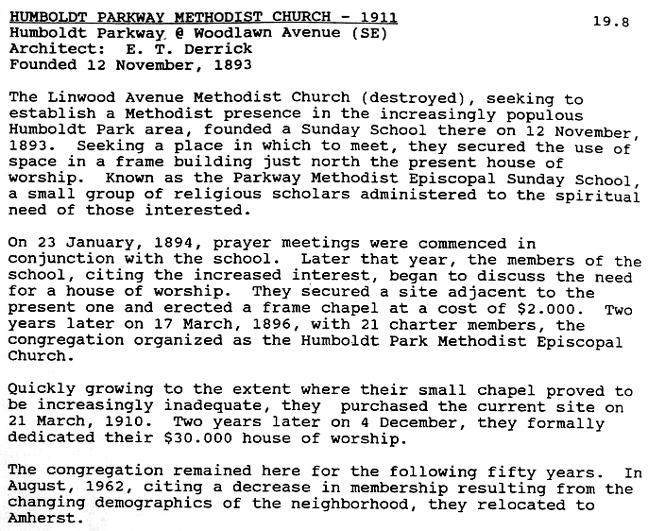Humboldt
Parkway Baptist Church - Table of Contents
Houses
of Worship - Table of Contents
Church History - Humboldt Parkway Baptist Church
790 Humboldt Parkway, Buffalo NY
Humboldt Parkway
Baptist Church, 790 Humboldt Parkway at Woodlawn Avenue,
Buffalo, New York, April 2020. A Gothic Revival design
executed in 1912 by architect E. T. Derrick, the church features
large stained-glass windows on both the west and north fašades,
and in between a stout, rectangular, flat-roofed steeple with
pairs of louvered windows topped with blunt Gothic arches, and
similarly ornamented entrance doors underneath. Though the congregation
that worships there today is Baptist, the building started as
home to the similarly named Humboldt Parkway Methodist Church,
which was founded in 1893 as a mission of the no-longer-extant
Linwood Avenue Methodist Church; the current building replaced a
smaller wood-frame chapel on a site just north of the present
one. Humboldt Parkway
Methodist existed until 1962, whereupon, citing the changing
demographics of the neighborhood, they moved to the suburbs. Humboldt Parkway Baptist has worshipped in this location since 1964; they are a continuation of the immensely historically important Michigan Street Baptist Church, which dates to 1844 and which, over the course of its history, played a pivotal role in the abolitionist and Civil Rights movements in Buffalo; they had abandoned their earlier building due also to changing demographics (demolition of much of its surrounding neighborhood for urban renewal had dispersed the congregation elsewhere in the city). Source: Andre Carrotflower, 25 April 2020 (online June 2024)
|
|
Elisha
Tucker, a prominent member of the First Baptist Church, initially
conceived the idea of organizing a Baptist congregation for Blacks
in 1836. One year later, 13 members of that congregation were
given letters of dismissal and set upon building a congregation of
their own. In doing so, they organized the first Black church of
any denomination in the city. With meager finances, the
congregation worshipped for their first seven years in a rented
room above an undertaker on Eagle at Niagara. Source: James Napora, Houses of Worship, 1995 |
 Source: James Napora, Houses of Worship, 1995 |
